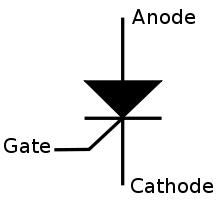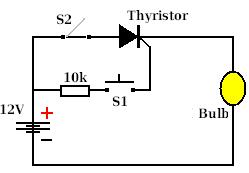In our article What is a Transistor we looked at transistors. A thyristor (aka Silicon Controlled Rectifier or SCR) is similar to a transistor in that a small input current into one pin switches a much larger current across two other pins – a small current into the base of a transistor allows a larger current to flow between its collector and emitter; and a small current into the gate of a thyristor allows a larger current to flow from the anode to the cathode.

What makes the thyristor different from a transistor and particularly useful is that when the current to the gate of the thyristor stops, the thyristor continues to allow current to flow from anode to cathode – i.e. it is latched ‘ON’. It is not possible to turn it ‘OFF’ again just by changing/removing the current to the gate – instead, the only way to turn if ‘OFF’ is to momentarily cut the current flowing to the device altogether.
Example Thyristor Circuit

Pictured above is a very simple example thyristor circuit schematic. When the momentary push button S1 is pressed, current flows through the resistor into the gate of the thyristor. This allows current to flow through the closed S2 switch, through the thyristor anode to cathode, and on to turn on the light bulb.
When the push button is released, the light bulb stays on, and will stay on until the switch S1 is opened cutting off the current to the thyristor anode. When that switch is subsequently closed again current will no longer flow from anode to cathode so the light bulb will stay off (until push button S1 is pressed again).
Using Thyristors
In the real world, the push button could for example be placed under a doormat to turn on a light or sound an alarm to show that an intruder has entered a building. It could also be used in a sump pump controller or well pump controller, with S1 and S2 replaced by float switches, and the light bulb replaced with a pump or a relay to switch a pump.
In the case of a sump pump controller, you want to turn on a pump when the water level in a container (the sump) is high and turn it off again when the sump has been pumped dry. One float switch would be positioned at the top of the sump (S1), and the second at the bottom of the sump (S2). When the water level gets high, the upper float switch would close (and the lower float switch would already be closed) – therefore the pump would turn on. As the water level drops, the upper float switch would open, but the pump would carry on pumping thanks to the thyristor until the sump is empty and the lower float switch opens cutting the current to the thyristor anode and resetting everything.
Buying Thyristors
There are many different types of thyristors available for all different application voltages and maximum currents. Click here to buy thyristors now.